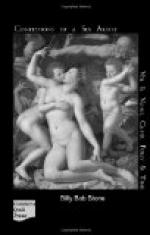|
This section contains 946 words (approx. 4 pages at 300 words per page) |

|
Bronzino and Moralizing Figures in the Allegory of Venus and Cupid.
Summary: Explores Bronzino's use of moralizing figures in the Allegory of Venus and Cupid. Discusses how it allows explicit depiction within a judgmental culture. Describes how Bronzino is able to balance the work with the use of symbols and figures that contrast with the demoralizing subject of the painting, creating a balance that is tolerable for the viewer.
Venus, the goddess of love, beauty, and desire, smiles as she allows her adolescent son, Cupid, to kiss her open mouth and fondle her breast. Without further explanation this seems inappropriate and almost repulsive, considering its creation around 1545 and its seemingly voyaristic court culture. Despite this, Bronzino is able to balance the work with the use of symbols and figures that contrast with the demoralizing subject of the painting, creating a balance that is tolerable for the viewer. Bronzino was born in 1503 as Angolo Di Cosimo in Florence, Italy, where he lived, worked and died in 1572. At a young age Bronzino studied as an apprentice to Pontormo. After he had built enough of a reputation for himself, Bronzino was appointed the official court painter for Cosimo Di Medici. "When the need arose for Cosimo to present prestigious diplomatic gifts, Bronzino's works were chosen; the Allegor of Venus, for...
|
This section contains 946 words (approx. 4 pages at 300 words per page) |

|


